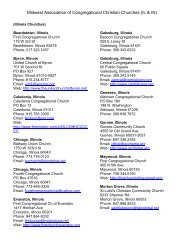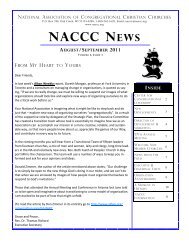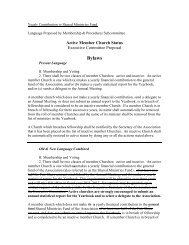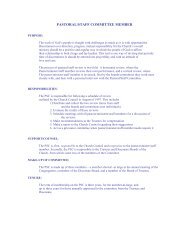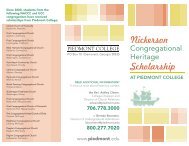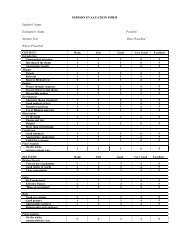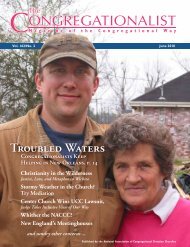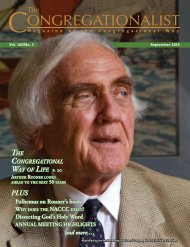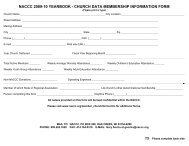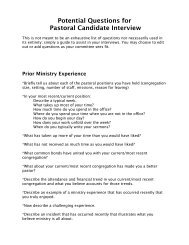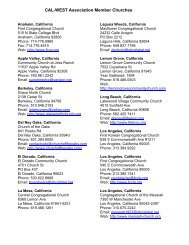8473 South Howell Avenue Oak Creek, WI 53154-0288 - National ...
8473 South Howell Avenue Oak Creek, WI 53154-0288 - National ...
8473 South Howell Avenue Oak Creek, WI 53154-0288 - National ...
You also want an ePaper? Increase the reach of your titles
YUMPU automatically turns print PDFs into web optimized ePapers that Google loves.
letter to John Winthrop in Boston, in which he says that the<br />
good people in London are convinced that the Massachusetts<br />
Bay Company’s purpose is Separatist and asks Winthrop to<br />
alleviate their fears and restore their “former good opinion of<br />
the company.” 11 How were “the good people of London” privy<br />
to news about Separatist Massachusetts in such a short time?<br />
It was only December, six months after the Arbella had<br />
docked in Salem. If Vassall left Salem in late July, he probably<br />
made it back to England by mid- or late September, plenty<br />
of time in which to spread the word around London of the<br />
Separatist nature of the plantation. It seems logical to conclude<br />
that Vassall, either alone or with some of the passengers from<br />
the Lyon and other returning ships, was responsible for painting<br />
the colony as “Separatist,” thereby causing such a stir among<br />
future investors skittish of the seditious label. 12<br />
The Lyon returned to Massachusetts on Feb. 5, 1631.<br />
It contained the much-needed provisions Winthrop had<br />
anxiously requested, plus 26 passengers and letters from<br />
friends back home. Dudley is sorrowed by what they have<br />
to say and continues his ongoing letter to Lady Bridget,<br />
lamenting that “they who went discontentedly from us the<br />
last year, out of their evil affections towards us, have raised<br />
many false and scandalous reports against us, affirming us to<br />
be Brownists in religion, and ill affected to our state at home,<br />
and that these vile reports have won credit with some who<br />
formerly wished us well.” 13 Might those people who formerly<br />
wished them well be the “good people of London” Humphrey<br />
wrote about in his letter to Winthrop?<br />
It is reasonable to conclude that Vassall himself was the bearer<br />
of such news and it is an early indication of the animosity that<br />
was to develop between Vassall and the political and religious<br />
establishment of the Massachusetts Bay.<br />
Despite the ill beginning, Vassall and his family decide to<br />
give Massachusetts another try five years later. This time he<br />
avoids the Bay and settles just a toe into Plimoth colony in a<br />
new town called Scituate, where he and his wife join the local<br />
church of John Lothrop. 14<br />
That move is significant. Plimoth colony was known for<br />
its tolerance and liberality. Vassall spent the next 11 years<br />
challenging autocratic voices in government and religion both<br />
in the Bay and in Plimoth colony, prompting John Winthrop<br />
to call him “a busy and factious spirit always opposite to the<br />
way of our churches and civil governments.” 15<br />
11 Andrews, ibid., 381.<br />
12 Queen Elizabeth and Parliament had decreed Separatism a crime in 1593.<br />
13 Young, ibid.,331.<br />
14 For more on Lothrop’s church, see Dan McConnell, “An Early Congregational<br />
Church Endures Persecution,” Th e Co n g r e g a T i o n a l i s T Vol. 164, No. 2<br />
(December 2010), 12-14.<br />
15 Richard S. Dunn, James Savage, Laetitia Yeandle, eds., The Journal of John Winthrop<br />
1630-1649 (Cambridge: Belknap Press of Harvard University Press, 1996), 624.<br />
But one man’s busy and factious spirit was another’s champion.<br />
The first decade into the Great Migration was a heady time for<br />
experimentation. Unconventional voices such as William Vassall,<br />
Roger Williams, and Anne Hutchinson show a great variety of<br />
views; and all three were challenged, albeit for different reasons,<br />
by the likes of Thomas Dudley and John Endicott.<br />
For Vassall or anyone else to taint the new plantation with<br />
the charge of Separatism (no matter how much the movement<br />
had altered itself since Robert Browne’s day) was scandalous<br />
to many Englishmen. That it would later become the working<br />
framework of the New England Way, Congregationalism, was<br />
in 1630 still an untested idea.<br />
For brevity’s sake the rest of Vassall’s long career as a maverick<br />
in New England is omitted here. The reader is encouraged to<br />
read Dorothy Carpenter’s account of his life, available online<br />
at http://home.gwi.net/~sscarpen/vassall/Vassall.pdf .<br />
li n D A k. pA l m E r is the founder and performer<br />
of the walking tour of 17th-century Boston called<br />
Where Did the Puritans Go? (www.puritantour.com),<br />
in which she portrays Ann Vassall,<br />
wife of William Vassall. She holds a Master of<br />
Arts in Teaching from Indiana University and is<br />
a frequent lecturer at historical societies, libraries<br />
and academic institutions throughout New England,<br />
including the Harvard Extension School<br />
and the Congregational Library.<br />
Seeking a Rich and Fulfilling Retirement?<br />
Consider the world-class opportunities in Fort Myers,<br />
Florida. Rich in history, culture and community.<br />
The caring church family of Thomas A. Edison<br />
Congregational Church welcomes you.<br />
1619 Llewellyn Drive<br />
Fort Myers, Florida 33901<br />
239.334.4978<br />
www.edisonchurch.org<br />
9



